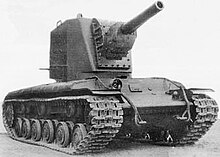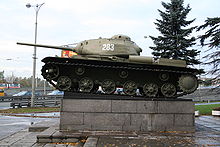KW series
The KW series is a range of Soviet heavy tanks that were built from 1939 to 1943. The type designation KW stands for K liment W oroschilow , the then People's Commissar of Defense; the tanks were designed and manufactured by Special Design Bureau No. 2 in the Leningrad Kirov factory . The KW series comprised various test samples and prototypes, of which the models KW-1 and KW-2 were manufactured in series. During the Second World War , tanks of the KW series were also manufactured in the Chelyabinsk Tractor Plant.
history
In the period between the Russian Civil War and the beginning of the Second World War, a number of tanks of different weight classes were built in the Soviet Union. The Soviet designers orientated themselves on the then trends of the international tank construction and tried to catch up with the technical backlog of the Soviet industry. For this purpose, various armored structures were purchased abroad, built under license and further developed. Heavy Soviet tanks of this period such as the T-35 , like their western counterparts, had multiple armored turrets in accordance with the doctrine of the time. The riveted armor had vertical surfaces and up to 13 crew members were required to operate. These tanks did not prove themselves in combat because they were too clumsy.
The last two representatives of the multi-turn armor were the two-tower prototypes SMK and T-100 , which were used against Finland in the 1939 winter campaign. In combat operations it became apparent that multi-turn armored vehicles were difficult to handle and could not use their weapons effectively.
On the technical basis of the progressive SMK of the Kirowwerk with a crew of seven, a somewhat shorter and lighter one-tower tank with a crew of five was constructed: the KW-1.
Series models
KW-1
The KW-1 was the first series-produced heavy tank of the KW series and the basis for all other KW models. In contrast to its predecessor, the SMK, the W-2 diesel engine with 500 hp, which also powered the T-34 , was used here for the first time . A total of 4800 pieces of the KW-1 were produced. All KW-1 had a 76.2 mm cannon as their main weapon; the 1939 prototype was the L-11 of the SMK, the series model until 1941 was the F-32 and then the SiS-5 was installed.
KW-2
The KW-2 was a variant of the KW-1 from 1940 armed with the 152 mm howitzer model M10. The hull and landing gear were identical; the prototype used in the Finnish War, like that of the KW-1, in contrast to the standard model, had none Bow MG. A new tower was constructed to accommodate the 152 mm howitzer. The KW-2 weighed 52 tons; about 300 pieces were made.
KW-1E
The KW-1E was a version from spring 1941 with additionally attached 35 mm armor plates.
KW-1S
The KW-1S was an upgraded KW-1, developed and manufactured in the Chelyabinsk tractor plant. It weighed 42.5 tons and was produced in a series of 1,230 from 1942 to 1943. The armor thickness of the hull was reduced compared to the KW-1 and it received a smaller cast turret. The KW-1S was powered by a W-2K with 600 hp. It was armed with the 76.2 mm SiS-5 cannon and equipped with a commander's cupola. It was more agile and faster than the KW-1.
KW-8 / KW-8S
The KW-8 was the flamethrower variant of the KW-1. Crew of four, combat weight 47 tons, developed in KB-2 Leningrad, manufactured in Chelyabinsk. Development began in 1941, it went into series production in 1942 and was armed with a 45 mm M1938 cannon and the ATO-41 flamethrower. The flamethrower had 670, later up to 960 liters of fire agent.
The version produced on the basis of the KW-1S from 1943 was called the KW-8S. The coaxial turret machine gun was omitted, in the course of production the ATO-41 was replaced by the improved ATO-42, whose fire agent supply was initially 600 and later 800 liters. The KW-8S was 5 tons lighter than the KW-8.
Week 14
Original designation of the self-propelled gun SU-152 based on the KW-1S.
KW-85
1943 transition model to the IS-1 , developed and manufactured in the Chelyabinsk Tractor Plant. The KW-85 consisted of the hull and landing gear of the KW-1S and the cast turret of the future IS-1 with the 85 mm D-5T cannon. Combat mass 46 tons. Like the T-34, the bow machine gun was relocated to the right side of the hull. The crew could be reduced by one man to four members, 130 KW-85 tanks were produced. The W-2K with 600 hp served as the drive.
Prototypes
KW-220
Prototype from 1941 (Object 220). The KW-220 was a design with a new drive with seven rollers and four support rollers. He weighed 63 tons. It was powered by a W-2KF diesel with an output of 850 hp. The main weapon was a 76.2 mm F-30 cannon, and the crew would have consisted of six men. The front armor was 100 mm thick on the turret and hull. Due to its high size, it was not mass-produced.
KW-3
Prototype from 1941 (Object 222). The KW-3 was an upgraded KW-1. It weighed 51 tons and was not mass-produced. The armor strength was increased compared to the KW-1, which led to weight gain and restricted mobility. The KW-3 was powered by a further developed W-2 diesel with the designation W-5 and an output of 700 hp. It was armed with the KW-1's 76.2 mm cannon and equipped with a commander's cupola.
KW-4
Various prototypes from 1941 were designated as KW-4 (Object 224). A petrol engine M-40 with 1200 HP was used as drive. There were different armament variants, some with an additional flamethrower:
- 107 mm cannon in turret mountings, the turret was mounted in the stern, additional turret on the main tower with the 45 mm cannon / later 76.2 mm cannon; Motor in the front part of the tub
- 76.2 mm L-11 cannon in the turret, turret in the middle, 107 mm cannon in casemate mount
- Turret similar to that of the Panther , 107 mm and 45 mm cannon in a coaxial arrangement; The engine is located in the front part of the hull between the turret and the driver seated in the front left, a MG DT in the rear armor of the turret, one in the commanders cupola, a bow MG DT
- short 107 mm cannon, ball segment additional turret with the 45 mm cannon on the main turret; Motor in the rear of the tub
The drive had eight rollers, the planned combat weight was specified with up to 90 tons, the armor with up to 130 mm.
KW-5
The KW-5 (Object 225) was a project for a super heavy tank weighing 100 tons, armor up to 180 mm and a 107 mm cannon.
KW-7
The KW-7 was a variant as an assault gun , i.e. without a turret. A prototype had one 76 mm cannon and two 45 mm cannons. Another prototype had two 76mm guns. At a demonstration in front of Josef Stalin on December 29, 1941 , he rejected the concept, which was then discontinued.
KW-9
The KW-9 was a prototype from 1942 based on the KW-1. It had a cast turret with a 122mm U-11 howitzer, a tank version of the M-30 , and weighed 47 tons. Due to the large amount of ammunition, the rate of fire decreased sharply and the ammunition supply dropped to 48 rounds. The howitzer was intended as a universal weapon with which one could fight tanks as well as give fire support. However, this concept was rejected by the armored forces. The front of the hull had been reinforced with 60 mm additional armor. The W-2K with 600 hp served as the drive.
KW-1K
The KW-1K was equipped with two launch boxes for RS-82 missiles . But since they were too imprecise, the idea was abandoned.
literature
- AW Karpenko: Soviet-Russian tanks . (1905-2003). Ed .: Rudi Meier. Elbe-Dnjepr, Klitzschen 2004, ISBN 978-3-933395-44-3 (Russian: Обозрение отечественной бронетанковой техники (1905–1995 гг) . Translated by Rudi Meier).
- Steven J. Zaloga, Jim Kinnear: KV-1 & 2 Heavy Tanks 1939–45. Oxford 1995.
Individual evidence
- ↑ Support roller running gear with torsion bar suspension, eight rollers, four support rollers, 55 t combat weight
- ↑ Support roller running gear with torsion bar suspension, six rollers, three support rollers, 47.5 t combat weight
- ↑ "F" in an engine designation stands for supercharged engines in Russian.















